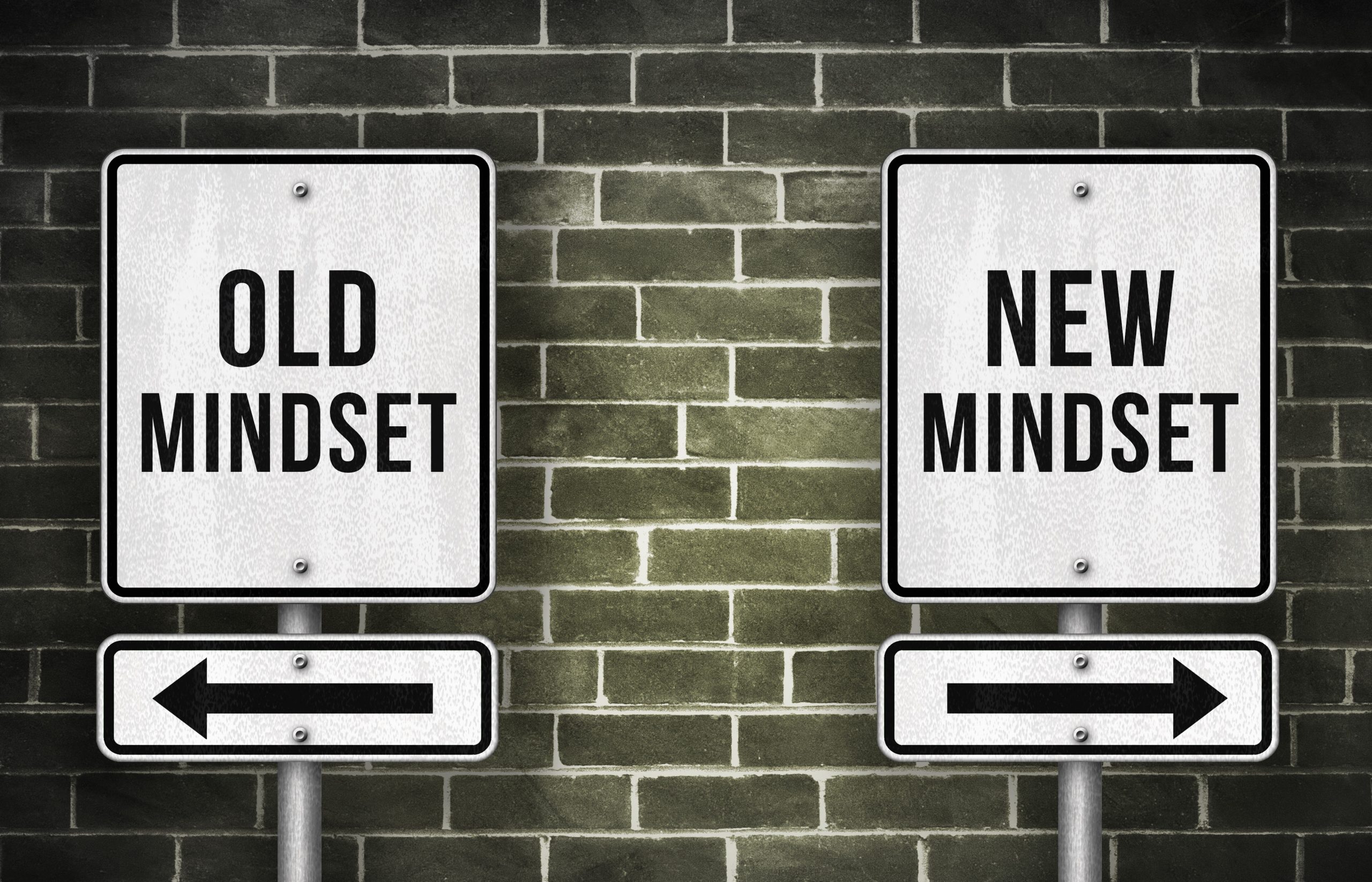In the previous article we provided an overview of service inclusion. Service inclusion refers to respecting the needs and perspectives of diverse people in all situations, ensuring that no one feels excluded or alienated as a recipient of our services, and to incorporating inclusive perspectives into key decision-making processes, from planning to release.
In this article, we will highlight how Rakuten is promoting its service inclusion initiatives.
The four phases for practicing service inclusion
The diagram below, based on information from Annie Jean-Baptiste’s book Building For Everyone: Expand Your Market With Design Practices From Google’s Product Inclusion Team (John Wiley & Sons, Inc.) (Jean-Baptiste, 2020), outlines the steps we are taking at Rakuten to advance service inclusion, which are divided into four phases.
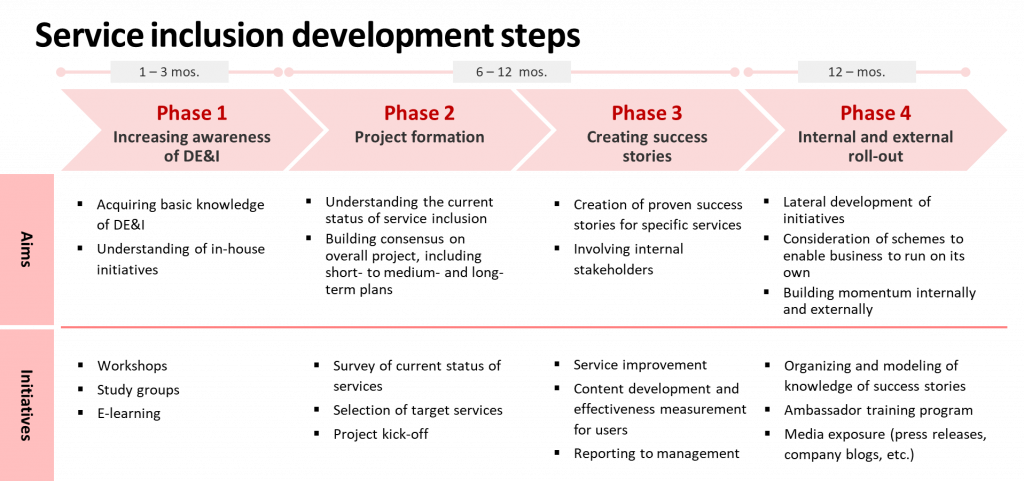
While the ultimate objective is to make Rakuten’s services easier for everyone to use, with over 70 services on offer, this is not something that can be achieved overnight. Accordingly, we are promoting this initiative with the aim of first building one success story to create a model that can be rolled out companywide.
Phase 1: Transforming to an inclusive mindset and culture
The first phase is to prepare the mindset and culture of those involved in the service to ensure they can handle diversity, choosing the appropriate words and actions. We aim to create a degree of knowledge understanding and common awareness in each organization regarding diversity, equity, and inclusion (DE&I), which is a prerequisite for everything.
As mentioned in the previous article, Rakuten’s mission is “empowering people and society through innovation.” And to realize this mission, our employees share a set of values and basic principles, called Rakuten Shugi, which, along with our mission, play an important role in fostering our corporate culture.
The adoption of English as the company’s official in-house language, which has led to an increased number of employees with diverse backgrounds, and the joining through acquisitions of organizations with completely different values and corporate cultures has created the need to boost our unifying strength based on a common direction and values.
But focusing exclusively on such activities could result in creating a highly exclusive environment for individuals and organizations with diverse backgrounds, or in imposing a select set of values on employees. Accordingly, Rakuten’s corporate culture is based on both the sharing of a common direction and values, and the promotion of diversity-related measures, and we promote activities aimed at creating a workplace where diverse individuals can demonstrate their abilities in the same direction in accordance with our internal regulations.
Specifically, the Human Resources Department and the Corporate Culture Division’s Diversity, Equity, Inclusion & Belonging (DEIB) Group work together to promote the acquisition of basic knowledge regarding DE&I and an understanding of existing related Rakuten initiatives through such means as workshops, study groups, and e-learning.
Examples of service inclusion in the sports industry
These efforts have already borne fruit. We held workshops to raise awareness of DE&I for the management companies of the Tohoku Rakuten Golden Eagles (Rakuten Eagles) professional baseball team and the Vissel Kobe professional soccer club. As a result, the Rakuten Eagles’ “Girl Day” event underwent a name change to be more inclusive and avoid alienating fans outside of a select demographic. Additionally, the key visuals for the special event websites for that event and one sponsored by Vissel Kobe targeting female fans were modified, moving away from the use of stereotypical gender-associated colors.
These are a couple of good examples demonstrating how the people in charge were able to change their mindset based on what they learned, which led to real change.
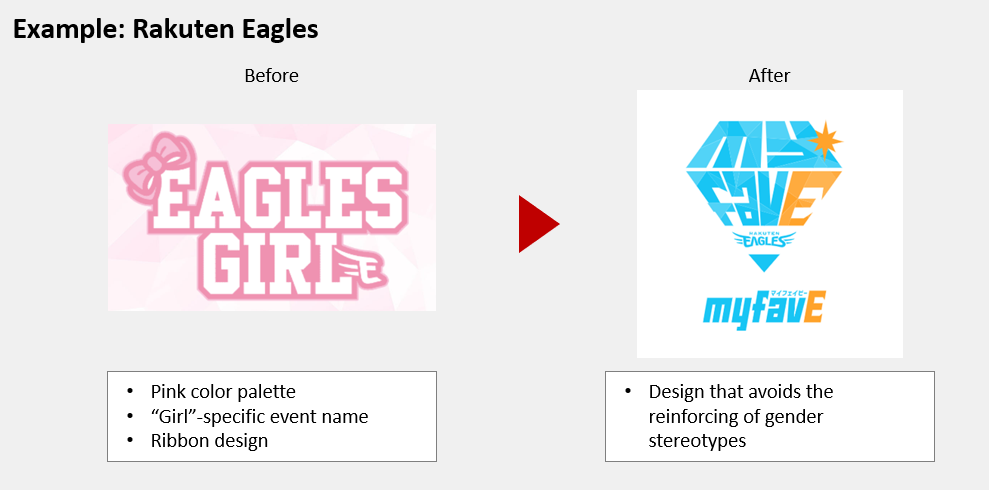
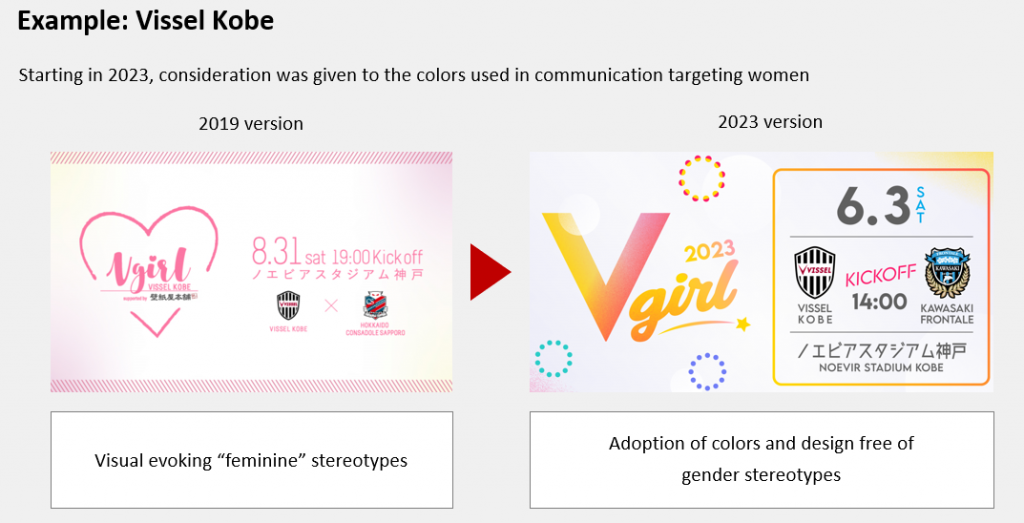
Phase 2-1: Understanding the degree of inclusiveness of our services
Phase 2 begins with understanding the situation on the ground and the company’s services in terms of how inclusive they are, as well as the current status regarding the level of awareness of the people involved (Phase 2-1). Based on these findings, short-, medium-, and long-term plans are made and consensus with management and business managers is built regarding the project (Phase 2-2).
In our case, to gain an understanding of the current situation, we conducted interviews with the business managers of each service within the Rakuten Group, as well as those in charge of development, quality control, and PR and marketing. As Rakuten offers more than 70 services, we initially limited our focus to the B2C services that we provide directly to end users. We asked such questions as “Are there any inclusive initiatives already being carried out as a business?” and “Have you received any feedback in the past about marketing that does not sufficiently address DE&I perspectives?” and held discussions with the people in charge.
Through this series of interviews, we learned that the reality of DE&I initiatives and the awareness of those in charge varied depending on the service. Some services were already focusing on concepts similar to service inclusion, such as pursuing accessibility for diverse users and incorporating such thinking into their service development.
For example, Rakuten Travel revised the page layout of its reservation site based on the perspective of foreigners, making it easier to use for foreign visitors to Japan. It also supports seven languages and 12 different currencies.
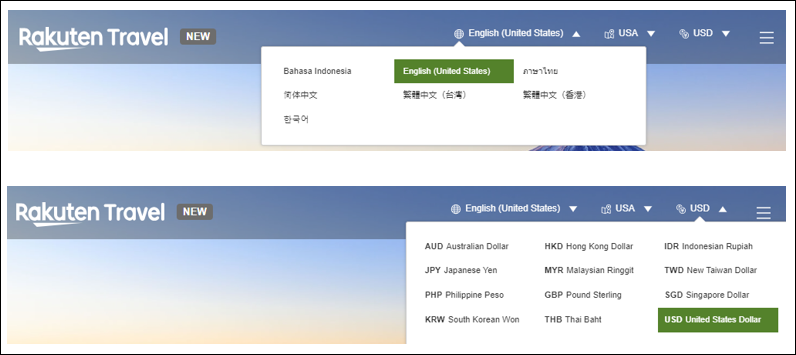
Among fintech services as well, we confirmed that some are increasingly taking an inclusive stance toward people with same-sex partners.
Rakuten Bank offers a dedicated service for LGBTQ+ clients that allows them to apply for a joint mortgage loan without the need to submit a partnership certificate. Additionally, other businesses also carry out service development and marketing with a diverse range of users in mind. For example, Rakuten Life Insurance and Rakuten General Insurance offer beneficiary coverage that is not limited to legal spouses, allowing same-sex partners to also receive death benefits and benefits for such mainstay products as automobile insurance and fire insurance, while Rakuten Card allows same-sex partners to apply for a family card.
Despite the existing examples introduced above, overall, awareness of DE&I among the employees involved in these services could not be described as sufficient. Additionally, some services responded that they were still in the process of considering various initiatives.
These findings suggest that there are many things that still need to be addressed before we are ready to carry out Phase 4, the service inclusion roll-out stage.
Accordingly, considering the differences in awareness and culture depending on the service or among the individual employees involved in the service, we determined it would not be a good idea to employ the same approach in rolling out service inclusion across all services at this time. Among Rakuten’s B2C services, we decided to select one in which the concept synergizes well with the business strategy and promote measures that prioritize the service’s success. We will then leverage the general knowledge and insight we gain with the aim of creating a model that we can apply laterally to other services.
Selecting the first partner business
As it turns out, as our first partner we selected Rakuten Beauty, a beauty salon reservation site operated by Rakuten. We decided to improve Rakuten Beauty’s service to make it pleasant and easy to use for users of all demographics, and to share the results of our efforts both inside and outside the company.
Let’s now look the process that led to the selection of Rakuten Beauty.
We first conducted surveys of and interviews with all of the Rakuten Group’s B2C services and selected five businesses, including Rakuten Beauty, based on whether they had a track record of DE&I initiatives or those in charge mentioned such initiatives as being important. The five businesses were then scrutinized based on the following three evaluation criteria.
The first concerned the sensitivity to DE&I of the people in charge. The reality is that many people are not aware that the services they are involved in are not inclusive.
The second criterion was whether inclusive initiatives could offer a competitive market advantage for the service in question.
And the third and final criterion was the lead time for implementation.
The strategic intent behind these evaluation criteria was to quickly demonstrate the effectiveness of such initiatives in a convincing manner, first with a “quick win” case study as an internal showcase, as we move forward to roll out a wide range of inclusive initiatives in the future.
In the end, following a comprehensive review of our evaluations, we decided on Rakuten Beauty as our partner to jointly create our initial success case study.
Empowering people and society beyond our own competitive advantage
Rakuten Beauty provides a hair salon reservation service for end users and, due to the nature of its business, is a service that requires gender sensitivity. But there are still harsh male- and female-based gender biases that often make LGBTQ+ people feel uncomfortable, and even when we looked at competing reservation sites, there were none with services that took such concerns into consideration.
Therefore, we felt that creating a progressive case study, such as Rakuten Beauty’s, based on service inclusion initiatives would not only provide us with a competitive business advantage but could also serve as a catalyst toward changing awareness throughout the entire industry. This should, eventually, lead to the well-being of LGBTQ+ people.
In this article we introduced the overall flow of the service inclusion development process at Rakuten along with Phases 1 and 2-1 of that process.
The first step toward realizing service inclusion is getting businesses to understand the meaning and significance of having a DE&I perspective on the services they provide and determine the current state of their services from this perspective.
In addition to the three evaluation criteria we introduced earlier to create the first success case study, there is another important point to take into account, which is the strength of the commitment of the service’s top management. As we have learned, the top executives’ determination and words are a powerful driving force in the workplace. Accordingly, this could represent the fourth criterion.
In the next installment we will introduce in detail how Rakuten Beauty promoted service inclusion and what the resulting output was.
Reference:
Jean-Baptiste, A. (2020). Building For Everyone: Expand Your Market with Design Practices From Google’s Product Inclusion Team. John Wiley & Sons, Inc.
Reference links:
・Rakuten Travel English top page
・Rakuten Bank: LGBT home loan (in Japanese)
・Rakuten Life Insurance FAQ: What range of people can be designated as a death insurance beneficiary? (in Japanese)
・Rakuten Card FAQ: Can same-sex partners (LGBT) also apply for a family card? (in Japanese)

